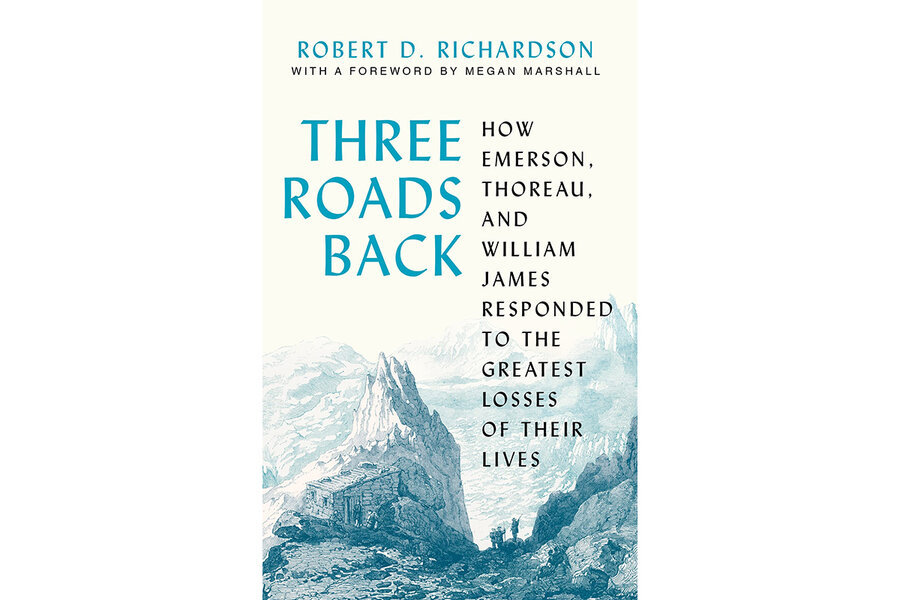Grief and resilience: Lessons from Emerson, Thoreau, and James
Loading...
Ralph Waldo Emerson, Henry David Thoreau, and William James are giants of American thought. But in “Three Roads Back: How Emerson, Thoreau, and William James Responded to the Greatest Losses of Their Lives,” Robert D. Richardson approaches them less as significant historical figures than as “fellow human beings, facing losses and troubles much like ours.”
Richardson, who died in 2020, was an acclaimed biographer of all three men. In this slim, profound volume, he argues that they each had formative experiences with grief that inspired their enduring contributions to intellectual history. He further suggests that their responses to loss can help guide modern-day readers who are navigating bereavement themselves.
To help readers connect emotionally with his storied subjects, Richardson deploys a method he calls “documentary biography”: he quotes extensively from their journals and correspondence, tracing each man’s reactions and revelations to a major loss.
In Emerson’s case, it was the 1831 death from illness of his first wife, Ellen, only 19 years old. Emerson was a Unitarian minister in Boston at the time, but, in his own words, “unstrung” and “debilitated by grief,” he resigned his position the following year and sailed for Europe.
Richardson lingers over Emerson’s momentous visit to the Paris botanical garden the Jardin des Plantes, where, the author writes, “the force of life entirely overpowers the feelings of loss and despair he had so recently plumbed.” Greatly moved by the orderliness and intelligence of the natural world, Emerson began to accept the place of death and decay within it. Upon his return to Boston he delivered a lecture on natural history that sketched out the ideas put forth in his first book, “Nature,” published in 1836. “Regeneration, not through Christ but through Nature, is the great theme of Emerson’s life,” the author writes, “and it came to him as a response to the death of his young wife Ellen.”
For Thoreau, the crisis that shook him was the accidental 1842 death of his brother John. Thoreau sought solace from his friend and mentor Emerson. But within days, Emerson, who had by then remarried, suffered another devastating blow himself: the death of his five-year-old son Waldo.
The two deaths “knocked [Thoreau] flat,” Richardson writes. But like Emerson had a decade earlier, Thoreau found comfort in the enduring fact of the natural world. The losses, the author continues, “connected him more solidly than ever with nature, with the rivers, the fields, and the forest.”
In March, Thoreau wrote a letter to Emerson about Waldo, telling his friend that death “is as common as life. … Every blade in the field – every leaf in the forest – lays down its life in its season as beautifully as it was taken up.” These ideas reached their maturity in the Spring chapter of Thoreau’s masterwork, “Walden,” which takes a nature-centered, rather than human-centered, view of natural processes. Through his experiences with grief, Thoreau reached an emotional, as opposed to merely intellectual, embrace of the cycles of life and death.
The link between loss and the groundbreaking work of psychologist and philosopher William James is a bit less direct. Richardson demonstrates that James and his brother, novelist Henry James, were greatly affected by the death of their sparkling 24-year-old cousin. “Minny Temple was simply and without question the most interesting, most intense, most intelligent young woman that William and Henry knew,” the author states. Late in his life, more than four decades later, Henry still vividly recalled the pain of the loss, writing that Minny’s death marked the end of the brothers’ youth.
James’ immediate response to the tragedy was recorded in his journal, in which he resolved to “ascend to some sort of partnership with fate, and since tragedy is at the heart of us, go to meet it, work it to our ends, instead of dodging it all our days, and being run down by it at last.” He began articulating the ideas that would form the basis of his achievements in psychology in the wake of his beloved cousin’s death. At their core, Richardson writes, they “have to do with what we might call strategies for encouraging resilience.”
Resilience, of course, is key to coping with the losses we all must face at one time or another. At the end of this elegant and affecting book, Richardson reminds us that fortitude is not only accessible to great thinkers; it is available to all of us.








